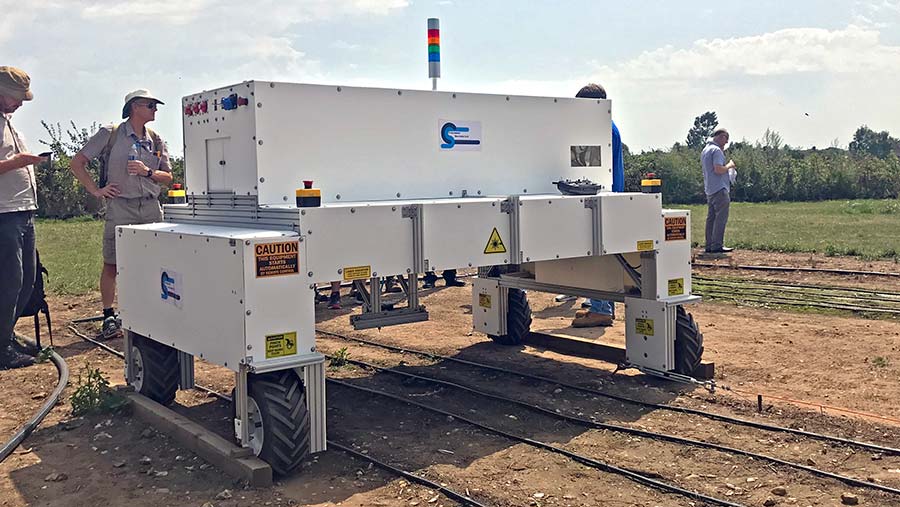Tech Talk: Experts’ verdict on the eyeSpot robot weeder
 The eyeSpot robot weeder working at a demo day at Reading University
The eyeSpot robot weeder working at a demo day at Reading University It can be hard to sort the wheat from the chaff when it comes to agri-technology, especially when so many new inventions promise to revolutionise the way we farm.
In Tech Talk, our experts give an honest assessment of the technologies arriving on farm soon. What are their pros and cons, and should you bother with them?
This week our panel takes a look at the eyeSpot robot, which effectively controls weeds while drastically reducing herbicide use – and the need for a sprayer operator.
Get in touch
If you have a farm technology you want our experts to look at, or would like to be on our expert panel, email johann.tasker@proagrica.com.
See also: Trial aims to identify most valuable technology for growers
What is it and what does it do?
A prototype automated weed-killing robot that targets individual plants with small amounts of chemical has reduced herbicide use on crops by up to 95%. The eyeSpot uses cameras to identify weeds – applying precise herbicide droplets to individual leaves.
Does it really work?
The eyeSpot represents a fundamental change in leaf-specific herbicide application, says researcher Nikolaos Koukiasas of Reading University. It achieves excellent weed control while reducing herbicide use by 95% in cabbages and 74% in leeks. It could also be used in sugar beet.
What are the challenges of getting it on farms?
A completely autonomous robot may be a step too far for some growers. It would also have to pass stringent safety legislation. For these reasons, the first eyeSpot is likely to be a pull-behind or mounted on a more traditional type sprayer, rather than driverless.
Which companies are likely to bring this to market?
Partners involved in the development of eyeSpot robot include Concurrent Solutions in the US. The remainder of the project is supported by Knight Farm Machinery and is partly funded by the AHDB and Douglas Bomford Trust.
When can I get one?
It’s too early to say – but sooner rather than later. Opportunities for commercialisation are being explored now. If later trials are successful, the eyeSpot will be made available to UK growers. Cost is yet to be decided – but it will be profitable and save growers money.
What the experts say
Sarah Pettitt, Lincolnshire brassica grower
There are lots of wins here – lower inputs, environmental benefits and a more nuanced approach to plant protection. I do have questions around the affordability for most growers compared with larger businesses.
Grant incentives for this sort of technology will be key – especially at first. I can see it taking the in-house skill set for crop protection out of the business and putting it in the hands of a specialist contractor. For some growers, that will be a step too far. For others, it will be welcome.
Verdict: Absolutely the way forward.
Johann Tasker
Farmers Weekly chief reporter
Choosing the first crop for commercialisation will be critical. It needs to provide sufficient economic benefit for farmers to adopt the system, while at the same time having a large enough customer base to make the eyeSpot profitable to manufacture.
The machine is designed to be highly adaptable from one crop to the next – but as a small company, Concurrent Solutions has limited resources. Costs must be kept to a minimum so it will be attractive to medium-sized farms.
Verdict: A game-changer – if price is right
Joe Martin
AHDB crop protection senior scientist
The robot significantly reduces herbicide use while practically eliminating any harm to non-target organisms. In terms of getting growers to buy into the concept, there is a lot of interest, but an autonomous machine could be expensive.
That said, this promises an alternative approach at a time when we are losing conventional chemistry quickly. The tipping point will come when it is financially beneficial for growers to adopt a more innovative approach to crop protection.
Verdict: Precision agriculture in action.
